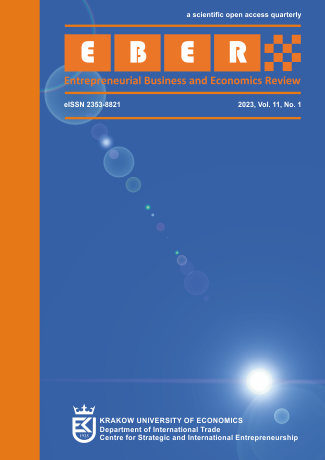Explaining the international opportunity recognition with the qualitative comparative analysis: The role of dynamic capabilities self-efficacy and global mindset
Explaining the international opportunity recognition with the qualitative comparative analysis: The role of dynamic capabilities self-efficacy and global mindset
Author(s): Omar Heredia-Portillo, Enrique Armas-ArévalosSubject(s): Business Economy / Management, Micro-Economics, Socio-Economic Research
Published by: Uniwersytet Ekonomiczny w Krakowie
Keywords: international entrepreneurship; international opportunity recognition; fuzzy-set qualitative comparative analysis (fsQCA); dynamic capabilities; global mindset; self-efficacy;
Summary/Abstract: Objective: The objective of the article is to explore the configurations of dynamic capability activities and the global mindset attributes of managers that lead to international opportunity recognition. Particularly, sensing ca- pability, seizing capability, transforming capability, networking capability, cognition, knowledge, and behaviour. Research Design & Methods: This was a quantitative study that uses a fuzzy set qualitative comparative anal- ysis (fsQCA) to analyse how different combinations of sensing capability, seizing capability, transforming ca- pability, networking capability, cognition, knowledge and behaviour are related to the international oppor- tunity recognition (IOR). The sample was made up of a manager from 21 Mexican micro and small companies in the information technology (IT) sector. All the analyses were performed in the QCA package in R.Findings: The findings suggest that without seizing capability, international opportunity recognitions cannot occur, and other conditions cannot compensate for their absences. There are three causal paths derived from dynamic capabilities and a global mindset that explain when managers of firms recognize opportunities abroad. Findings also show that the seizing and networking conditions are present in the three causal paths that lead to IOR. There are no paths that lead to international opportunity recognitions without the presence of seizing and networking, reflecting their relative importance in guaranteeing IOR. On the other hand, the results show the asymmetric causality of the IOR, in which different sets of conditions are observable for the occurrence and non-occurrence of the IOR, which does not constitute a reversal of the same conditions. Implications & Recommendations: The results confirm that managers seeking to recognize international op- portunities can benefit from a high level of dynamic capabilities, self-efficacy, and a global mindset. These factors can be reinforced by investing in training, education, or experiential learning; or by recruiting a man- ager with high levels of these factors. In the same way, policymakers can establish programs that allow the reinforcement of these factors. Finally, given the smaller sample size, future research can test this framework across larger datasets, contexts, and time to test the model’s reliability.Contribution & Value Added: The results of this study reinforce the existing literature on the effect of man- ager dynamic capabilities and global mindset on IOR. It helps to verify the assumptions of Andersson and Evers (2015) and Tabares et al. (2021) about manager-level factors that influence IOR, by showing that the combi- nation of explanatory conditions derived from dynamic capabilities and a global mindset explains when a manager recognizes opportunities abroad.
Journal: Entrepreneurial Business and Economics Review
- Issue Year: 11/2023
- Issue No: 1
- Page Range: 29-56
- Page Count: 28
- Language: English

